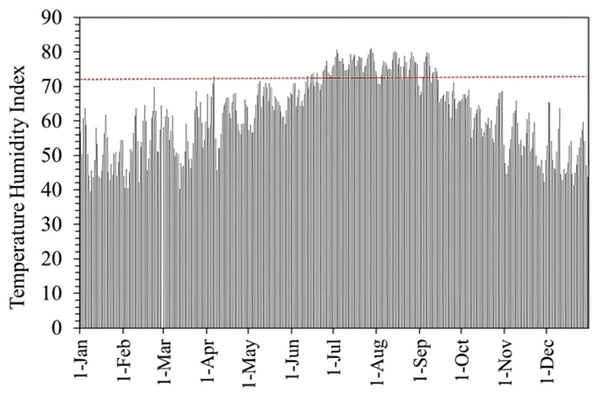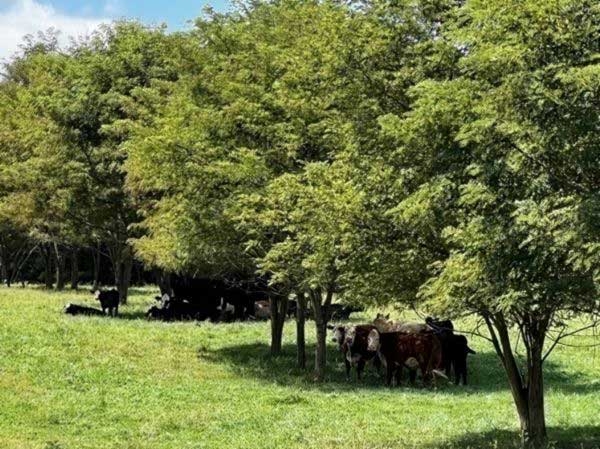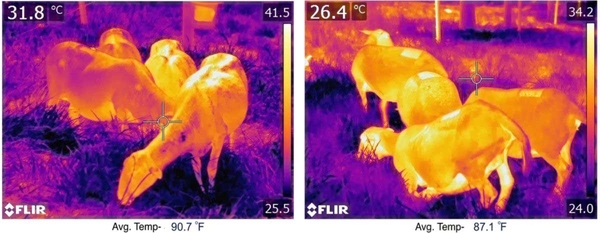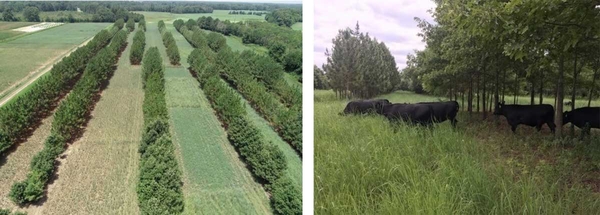Introduction
Silvopasture is a type of agroforestry system that integrates trees, forage, and livestock under a common management unit. The scope and potential of silvopastures to mitigate heat stress in the southeastern United States are significant, given the region's warm and humid climatic conditions along with the extended growing season. This region has diverse flora that provide ample opportunity to design silvopasture systems tailored to local conditions and needs. Silvopastures offer the potential to increase economic returns per unit area by diversifying farm income sources and improving livestock productivity and welfare through better microclimatic conditions (Clason and Sharrow, 2000). Silvopastures may also play a role in carbon sequestration (Montagnini and Nair, 2004), which could open avenues to get into carbon trading programs and generate additional revenue for producers (Holderieath et al., 2012). The adoption of silvopasture in the southeastern United States could serve as a model for sustainable and climate-resilient livestock farming, addressing both environmental and economic challenges faced by the region's agricultural sector.
Heat Stress in Livestock
Heat stress represents a significant challenge to livestock production. The economic loss due to heat stress was estimated to be about $1.5 billion annually for the US dairy industry alone (Key et al., 2014). Heat stress affects not only dairy cattle but also beef cattle, small ruminants, swine, and poultry, potentially leading to a comprehensive economic burden across the livestock sector.
The temperature-humidity index (THI), which combines air temperature and relative humidity, serves as one reference metric to assess when environmental conditions can adversely affect livestock health and productivity. When THI values exceed 72, livestock typically exhibit signs of heat stress (Aguilar et al., 2010). Across the southeast US, THI values ≥ 72 could potentially be reached for at least about a third of the year (~100 to 150 days) (Castillo et al., 2020). As an example, the THI exceeded the threshold of 72 for approximately eighty-six days in North Carolina during 2023, primarily during the summer months (Figure 1).
Some of the critical signs of heat stress in livestock include increased respiration rates, reduced feed intake, and a decline in reproductive efficiency. When animals experience heat stress, they use a significant amount of their energy to regulate their body temperature to maintain a thermostatic balance instead of using it for growth and development. To help manage their internal heat, livestock intentionally eat less. This reduction in feed intake is a strategy to decrease the metabolic heat produced by their bodies during digestion, which can exacerbate the heat stress level. Consequently, over time, animals suffering from heat stress tend to reduce weight and overall productivity. Shade provided by the tree component of silvopasture can help alleviate heat stress by providing shelter or serving as an “umbrella effect” to reduce the amount of direct solar radiation received by livestock (Figure 2 and Figure 3). The images in Figure 3 illustrate the thermal stress differences between the two environments, highlighting how ewes in silvopasture exhibit cooler body temperatures indicative of reduced heat stress.
Silvopasture Landscapes
In silvopastures, trees can be deliberately planted or naturally occurring and should be managed together with forages and livestock to optimize the benefits of each component. Silvopastures can be developed by planting trees in already established pastures, or by strategically thinning out forests to create open areas for pasture development. There is no single design for a silvopasture to be applied everywhere; rather, each component, including the distribution of trees in the landscape and selection of trees, forages, and livestock, can and should be managed considering the goals and challenges of each operation.
The strategic use of trees in pastures can help reduce heat stress in animals by providing necessary shade (Figure 2) and altering the microclimate. For example, the presence of trees in a silvopasture in North Carolina resulted in up to 1.5 points lower THI under the trees during the day and 0.5 points higher THI at night compared to open pastures (Castillo et al., 2020; Figure 4). The system in Figure 4 is designed with 20- and 40-foot alleys to maximize sunlight penetration between the lines of trees for optimum growth of native warm-season grasses; each line of trees consists of three rows of trees designed to maximize shade under the trees. The trees are loblolly pine, longleaf pine, or cherrybark oak. In that same silvopasture, the shade was measured as a function of tree type (loblolly pine, longleaf pine, and cherrybark oak) and distance to the trees during winter and summer months. In the middle of a 40-foot alley between rows of trees, shade was nil (0%) during winter and summer; however, under the rows of trees, shade was ≥ 80% during summer. During the winter, the shade under the trees was 30% for cherrybark oak, and 50% for both types of pines (loblolly and longleaf).
Silvopastures Reduce Heat Stress in Livestock
Exposure to heat stress reduces overall livestock performance and can negatively affect reproductive processes, such as leading to reduced fertilization (Paul et al., 2008), DNA damage in the sperm (Pérez‐Crespo et al., 2008), decreased secretion of hormones (Wettemann and Desjardins, 1979), and decreased fertility (Al-Katanani et al., 1999). Although ambient atmospheric temperatures and relative humidity may not necessarily be drastically different under the trees compared to open (treeless) pastures, the strategic management of trees and the shade provided by trees can significantly mitigate the adverse effects of heat stress on livestock by reducing the amount of direct solar radiation received by livestock. Livestock grazing in silvopastures exhibit lower signs of heat stress, especially during the daytime, as evidenced by lower core body temperature compared to their counterparts in conventional open (treeless) pastures (Figure 5).
Silvopastures Improve Animal Welfare
Silvopasture offers a compelling solution to enhancing livestock welfare, particularly in regions vulnerable to extreme weather conditions such as high temperatures and humidity. By providing a natural canopy, silvopastures offer shelter and shade, critical elements that reduce heat stress and physical discomfort among livestock during periods of high temperature and humidity (see Figure 3). Alleviation of environmental stressors fosters conditions conducive to better health and increased productivity. Improved environmental conditions for livestock not only shield livestock from the direct impacts of heat stress but also mitigate risks associated with thermal discomfort, including dehydration and heat exhaustion.
Livestock grazing in silvopastures also exhibit behavioral changes. As an example, livestock grazing in silvopasture spend a significant amount of diurnal time lying down using the shade and appearing relaxed and less stressed, even during periods of high temperature and humidity, indicative of improved overall welfare (Poudel et al., 2022; Pent et al., 2020; Figure 6). In contrast, livestock in open (treeless) pastures exhibit stress by spending a significant amount of diurnal time standing, congregating closely together, and attempting to bury their heads underneath other animals, indicative of stressed behavior, during these same conditions (Poudel et al., 2022; Pent et al., 2020; Figure 7).
Silvopasture Improves Livestock Productivity
Lower heat stress and improved welfare within the silvopasture system can also help improve livestock gain and reproductive performance (Lemes et al., 2021; Poudel et al., 2022). The integration of different tree species within the silvopasture system can provide additional feeding resources for livestock and improve overall pasture productivity (Dubeux et al., 2017; Pent and Fike, 2019; Gomes da Silva et al., 2021). Silvopastures can also be a potential solution to mitigate the effects of fescue toxicosis and associated heat stress, especially in the fescue belt where tall fescue is a predominant cool-season pasture forage mostly infected by toxic alkaloid-producing endophytes. By providing shade through strategic tree planting, silvopasture can alleviate heat stress symptoms associated with fescue toxicosis while resulting in overall improved productivity of livestock (Table 1). As the agricultural sector continues to seek innovative solutions to sustainably increase productivity while ensuring animal welfare, silvopasture emerges as a critical practice that harmonizes economic and environmental objectives.
Source: (Kallenbach, 2015)
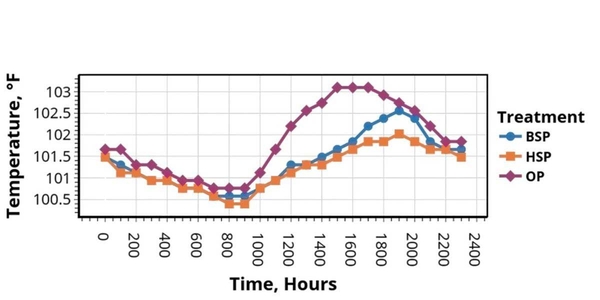
Figure 5. Intravaginal temperatures of Katahdin ewes in black walnut silvopasture (BSP), honey locust silvopasture (HSP), and open pasture (OP) in Blacksburg, Virginia. Ewes in silvopasture exhibited about 1.0 to 1.5ºF lower intravaginal temperatures, particularly during daytime hours, than those in OP.
(Poudel et al., 2022)
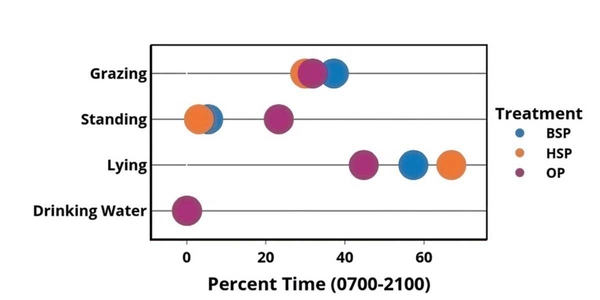
Figure 6. Diurnal behavior of Katahdin ewes in black walnut silvopasture (BSP), honey locust silvopasture (HSP), and open pasture (OP) in Blacksburg, Virginia. Ewes in silvopasture spent less time standing and more time lying down compared to those in OP, indicating behavioral differences between the environments.
(Poudel et al., 2022)
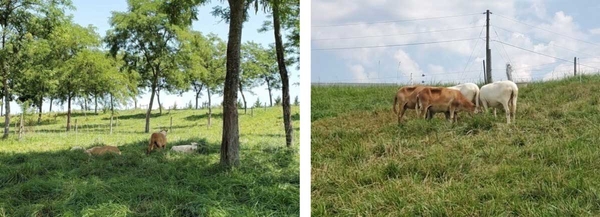
Figure 7. Ewes' behavior in an OP (left) and in a silvopasture (right) during summer daytime in Blacksburg, Virginia. In the OP, ewes display signs of stress by clustering together and attempting to bury their heads under other animals. Conversely, ewes in the silvopasture appear more relaxed, lying down comfortably.
Photo credit: Sanjok Poudel
Take-home Messages
This publication summarizes animal responses and microclimate measurements from work conducted in, mainly, two silvopastoral systems in Virginia and North Carolina. The intentional integration of trees, forage, and livestock, known as silvopasture, holds the promise of fostering more resilient agricultural systems by alleviating heat stress and improving livestock welfare, offering a diversified source of income (from trees, forages, and livestock), and enhancing productivity and quality of the overall agricultural system. Considering the climatic conditions in the southeastern United States, silvopasture has the potential to play a key role in improving livestock responses and in the development of resilient agroforestry systems.
References
Aguilar, I., I. Misztal, S., and Tsuruta. 2010. “Genetic Trends of Milk Yield Under Heat Stress for US Holsteins.” Journal of Dairy Science 93(4): 1754–1758. ↲
Al-Katanani, Y.M., D.W. Webb, and P.J. Hansen. 1999. “Factors Affecting Seasonal Variation in 90-Day Nonreturn Rate to First Service in Lactating Holstein Cows in a Hot Climate.” Journal of Dairy Science 82: 2611–2616. ↲
Castillo, M.S., F. Tiezzi, and A.J. Franzluebbers. 2020. “Tree Species Effects on Understory Forage Productivity and Microclimate in a Silvopasture of the Southeastern USA.” Agriculture, Ecosystems, and Environment. ↲
Clason, T.R., and S.H. Sharro. 2000. “Silvopastoral Practices.” In North American Agroforestry: An Integrated Science and Practice. edited by H.E. Garrett, W.J. Rietveld, and R.F. Fisher. American Society of Agronomy, pp. 119–147. ↲
Dubeux, Jr., J.C.B., J.P. Muir, V.X.D.O. Apolinário, P.R. Nair, M.D.A. Lira, and L.E. Sollenberger. 2017. “Tree Legumes: An Underexploited Resource in Warm-climate Silvopastures.” Revista Brasileira de Zootecnia 46(8): 689–703. ↲
Gomes da Silva, I.A., J.C.B. Dubeux Jr., A.C.L. de Melo, M.V. da Cunha, M.V.F. dos Santos, V.X.O. Apolinário, and E. de Freitas. 2021. “Tree Legume Enhances Livestock Performance in a Silvopasture System.” Agronomy Journal 113(1): 358–369. ↲
Holderieath, J., C. Valdivia, L. Godsey, and C. Barbieri. 2012. “The Potential for Carbon Offset Trading to Provide Added Incentive to Adopt Silvopasture and Alley Cropping in Missouri.” Agroforestry Systems 86: 345–353. ↲
Kallenbach, R. 2015. “Silvopasture: Creating Climate-smart Pastoral Systems.” 6th Annual Agroforestry Symposium. University of Missouri. ↲
Key, N., S. Sneeringer, and D. Marquardt. 2014. “Climate Change, Heat Stress, and U.S. Dairy Production,” United States Department of Agriculture. ↲
Lemes, A.P., A.R. Garcia, J.R.M. Pezzopane, F.Z. Brandão, Y.F. Watanabe, et al. 2021. “Silvopastoral System Is an Alternative to Improve Animal Welfare and Productive Performance in Meat Production Systems.” Scientific Reports 11(1), 14092. ↲
Montagnini, F., and P.R. Nair. 2004. “Carbon Sequestration: An Underexploited Environmental Benefit of Agroforestry Systems.” In New Vistas in Agroforestry: A Compendium for 1st World Congress of Agroforestry, pp. 281–295. Springer. ↲
Paul, C., A.A. Murray, N. Spears, and P.T.K. Saunders. 2008. “A Single, Mild, Transient Scrotal Heat Stress Causes DNA Damage, Subfertility and Impairs Formation of Blastocysts in Mice.” Reproduction 136: 73–84. ↲
Pent, G.J., and J.H. Fike. 2019. “Lamb Productivity on Stockpiled Fescue in Honeylocust and Black Walnut Silvopastures.” Agroforestry Systems 93: 113–121. ↲
Pent, G.J., S.P. Greiner, J.F. Munsell, B.F. Tracy, and J.H. Fike. 2020. “Lamb Performance in Hardwood Silvopastures, II: Animal Behavior in Summer.” Translational Animal Science 4(1): 363–375. ↲
Pérez-Crespo, M., B. Pintado, and A. Gutiérrdán. 2008. “Scrotal Heat Stress Effects on Sperm Viability, Sperm DNA Integrity, and the Offspring Sex Ratio in Mice.” Molecular Reproduction and Development 75: 40–47.
Poudel, S., J.H. Fike, and G.J. Pent. 2022. “Hair Cortisol as a Measure of Chronic Stress in Ewes Grazing Either Hardwood Silvopastures or Open Pastures.” Agronomy 12(7): 1566. ↲
Wettemann, R. P., and C. Desjardins. 1979. “Testicular Function in Boars Exposed to Elevated Ambient Temperature.” Biology of Reproduction 20: 235–241. ↲
Publication date: Nov. 8, 2024
AG-977
N.C. Cooperative Extension prohibits discrimination and harassment regardless of age, color, disability, family and marital status, gender identity, national origin, political beliefs, race, religion, sex (including pregnancy), sexual orientation and veteran status.

